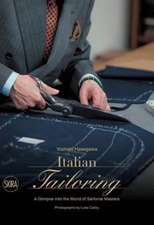Japanese Fashion: A Cultural History
Autor Toby Sladeen Limba Engleză Hardback – 31 oct 2009
The book is unique in that it provides the first full history of the last 200 years of Japanese clothing. It is also the first book to include Asian fashion as part of global fashion as well as fashion theory. It adds a hitherto absent continuity to the understanding of historical and current fashion in Japan, and is pioneering in offering possible theories to account for that entire history. By providing an analysis of how that entire history changes our understanding of the way fashion works, this book will be an essential text for all students of fashion and design.
| Toate formatele și edițiile | Preț | Express |
|---|---|---|
| Paperback (1) | 218.47 lei 43-57 zile | |
| Bloomsbury Publishing – 31 oct 2009 | 218.47 lei 43-57 zile | |
| Hardback (1) | 598.02 lei 43-57 zile | |
| Bloomsbury Publishing – 31 oct 2009 | 598.02 lei 43-57 zile |
Preț: 598.02 lei
Preț vechi: 764.13 lei
-22% Nou
Puncte Express: 897
Preț estimativ în valută:
114.43€ • 119.78$ • 95.24£
114.43€ • 119.78$ • 95.24£
Carte tipărită la comandă
Livrare economică 31 martie-14 aprilie
Preluare comenzi: 021 569.72.76
Specificații
ISBN-13: 9781847882530
ISBN-10: 1847882536
Pagini: 192
Ilustrații: bibliography, index
Dimensiuni: 156 x 234 x 14 mm
Greutate: 0.5 kg
Editura: Bloomsbury Publishing
Colecția Berg Publishers
Locul publicării:London, United Kingdom
ISBN-10: 1847882536
Pagini: 192
Ilustrații: bibliography, index
Dimensiuni: 156 x 234 x 14 mm
Greutate: 0.5 kg
Editura: Bloomsbury Publishing
Colecția Berg Publishers
Locul publicării:London, United Kingdom
Caracteristici
Also available in paperback, 9781847882523 £17.99 (November, 2009)
Notă biografică
Toby Slade has a Ph.D. in Art History and Theory from Sydney University, where his main area of research was Japanese fashion. He has taught fashion history at the University of Technology Sydney and is currently lecturing in fashion theory at Keio University in Tokyo.
Cuprins
1. Introduction: Modernity, Fashion and Japan
Modernity and Modernity in Clothing
Global Fashion and National Cultures
Japan
2. Japanese Clothes 1800-2000
Clothing in the Edo Period
Nakedness and Covering It
Decency
Foundation Choices: Yoga and Nihonga
Materials and Materialism
'Westernisation' and Japanese Fashion
Textile Industrialisation
The Democratisation of Consumption
World War II
The Rise of Designers
Today's Subcultures
3. Japanese Menswear: Masculinity and Sartorial Statecraft
Uniforms and the State: The Emperor's New Clothes
Suits: Modern and Classic Masculinity
The Suit in Europe and America
The Growing Civilised Centre
The Japanese Suit
The Rokumeikan
Modern Boys
Possible Masculinities post 2000
4. Japanese Womenswear: Femininity and Modernity
Traditional Notions of Sartorial Womanhood
Meiji Girl Students and School Uniforms
Taisho Decadence and the Moga
Sportswear, Swimwear & Movement
Cosmetics and Substance
Hairstyles: The First Experiments
Kimono Reform and Traditional Identity
Feminine Formality and Time
1960s Counter Culture in Japan
Japanese Femininity Today
5. Conclusions: Theories of Japanese Fashion
The Economics of Aesthetics
A Set of Reoccurring Questions
Functional Explanations
Fashion as the Search for Meaning and/or Identity
Fashion and the Struggle for Status
The Economics of Fashion
Fashion as Communication
Dynamic Explanations of Fashion
Fashion as Diffusion
Cycles of Fashion
Fashion as Erotic
Fashion and the Zeitgeist
Fashion as Aesthetics
Acknowledgements
Bibliography
Modernity and Modernity in Clothing
Global Fashion and National Cultures
Japan
2. Japanese Clothes 1800-2000
Clothing in the Edo Period
Nakedness and Covering It
Decency
Foundation Choices: Yoga and Nihonga
Materials and Materialism
'Westernisation' and Japanese Fashion
Textile Industrialisation
The Democratisation of Consumption
World War II
The Rise of Designers
Today's Subcultures
3. Japanese Menswear: Masculinity and Sartorial Statecraft
Uniforms and the State: The Emperor's New Clothes
Suits: Modern and Classic Masculinity
The Suit in Europe and America
The Growing Civilised Centre
The Japanese Suit
The Rokumeikan
Modern Boys
Possible Masculinities post 2000
4. Japanese Womenswear: Femininity and Modernity
Traditional Notions of Sartorial Womanhood
Meiji Girl Students and School Uniforms
Taisho Decadence and the Moga
Sportswear, Swimwear & Movement
Cosmetics and Substance
Hairstyles: The First Experiments
Kimono Reform and Traditional Identity
Feminine Formality and Time
1960s Counter Culture in Japan
Japanese Femininity Today
5. Conclusions: Theories of Japanese Fashion
The Economics of Aesthetics
A Set of Reoccurring Questions
Functional Explanations
Fashion as the Search for Meaning and/or Identity
Fashion and the Struggle for Status
The Economics of Fashion
Fashion as Communication
Dynamic Explanations of Fashion
Fashion as Diffusion
Cycles of Fashion
Fashion as Erotic
Fashion and the Zeitgeist
Fashion as Aesthetics
Acknowledgements
Bibliography
Recenzii
Slade sets himself very ambitious targets in Japanese Fashion: A Cultural History, an analytical survey of a whole clothing culture, which he successfully meets. Dr. Slade is an imaginative historian who has the ability to synthesize a wide range of sources, ranging from the offical record to the ephemeral and teh vernacular.
Descriere
Examines the entire sweep of Japanese clothing history, from the sophisticated fashion systems of late-Edo period kimonos onwards, providing possible theories of how Japan made this fashion journey and linking theories of fashion to the Japanese example. This book provides a full history of the last 200 years of Japanese clothing.








